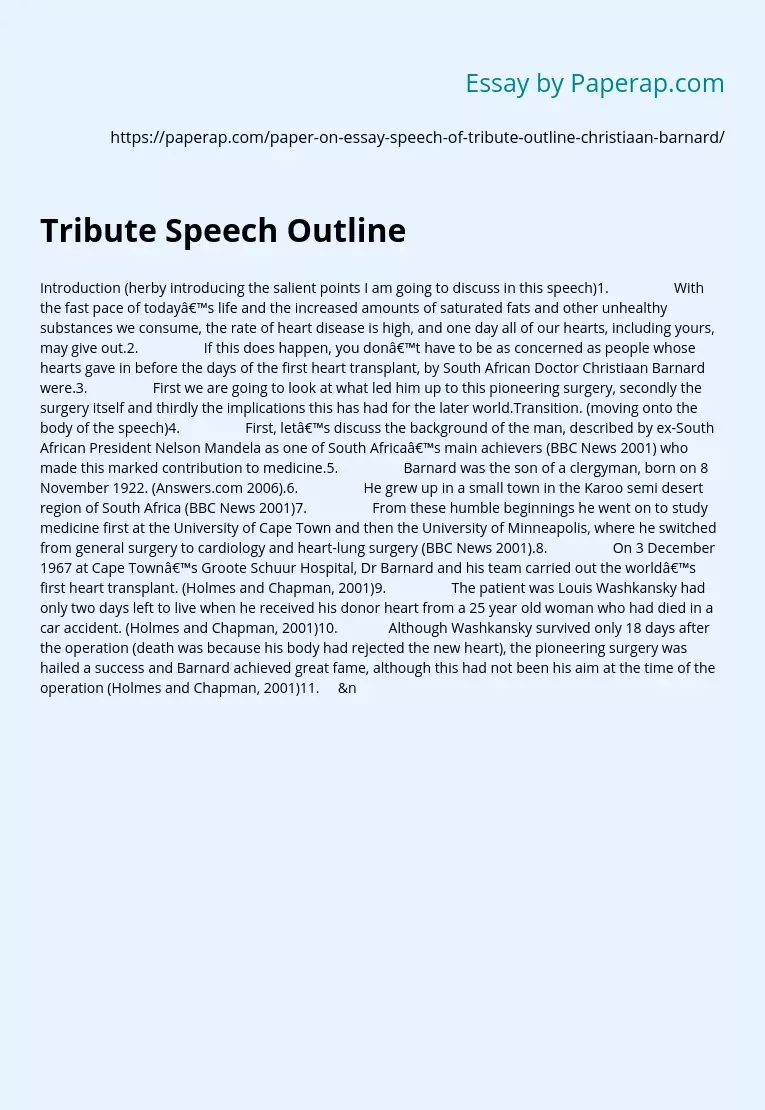Tribute Speech Outline
Introduction (herby introducing the salient points I am going to discuss in this speech)1. With the fast pace of today’s life and the increased amounts of saturated fats and other unhealthy substances we consume, the rate of heart disease is high, and one day all of our hearts, including yours, may give out.2. If this does happen, you don’t have to be as concerned as people whose hearts gave in before the days of the first heart transplant, by South African Doctor Christiaan Barnard were.
3. First we are going to look at what led him up to this pioneering surgery, secondly the surgery itself and thirdly the implications this has had for the later world.
Transition. (moving onto the body of the speech)4. First, let’s discuss the background of the man, described by ex-South African President Nelson Mandela as one of South Africa’s main achievers (BBC News 2001) who made this marked contribution to medicine.5. Barnard was the son of a clergyman, born on 8 November 1922.
(Answers.com 2006).6. He grew up in a small town in the Karoo semi desert region of South Africa (BBC News 2001)7. From these humble beginnings he went on to study medicine first at the University of Cape Town and then the University of Minneapolis, where he switched from general surgery to cardiology and heart-lung surgery (BBC News 2001).8. On 3 December 1967 at Cape Town’s Groote Schuur Hospital, Dr Barnard and his team carried out the world’s first heart transplant. (Holmes and Chapman, 2001)9. The patient was Louis Washkansky had only two days left to live when he received his donor heart from a 25 year old woman who had died in a car accident. (Holmes and Chapman, 2001)10. Although Washkansky survived only 18 days after the operation (death was because his body had rejected the new heart), the pioneering surgery was hailed a success and Barnard achieved great fame, although this had not been his aim at the time of the operation (Holmes and Chapman, 2001)11. The operation was made more remarkable by the fact that it was achieved in South Africa by a South African from a small town, as opposed to a surgeon from a much larger country.12. The operation did not only spark awe and acclaim, but also concern and criticism as some felt it was done too early, and was experimental. Barnard himself said, after the death of his patient “I wouldn’t like to call this operation an experiment – it was the treatment of a sick patient. Although Washkansky died, I don’t think we have any evidence that transplantation is not good treatment for certain heart diseases” (Swazey and Fox, 2004)13. Indeed, today there is positive evidence that transplantation IS good treatment for heart diseases: Approximately 1,600 heart transplants are performed each year in the United States. (Miller, 1996)14. Within a very short space of time a number of American surgeons including Adrian Kantrowitz and Norman Shumway also performed transplants. In 1968 108 transplants were performed, and in November of that year alone, 26. (Rothman, 1991)15. Francis Moore, who was a professor of surgery at Harvard and at Peter Bent Brigham Hospital and author of a book about the ethics of kidney transplants, “Give and Take” immediately recognized the implications of heart transplants for medical ethics, including the true definition of death, (Rothman, 1991).16. In heart transplantation it is urgently necessary that the donated heart be as fresh as possible, and therefore the question is raised as to who decides whether or not the donor is dead. (Jecker, 1997)17. Nevertheless the pioneering surgery has paved the way for many advances in the field. Since 1981, combined heart and lung transplants have been used to treat patients with conditions that severely damage both these organs. As of 1990, about 800 people worldwide have received heart/lung transplants. (Miller, 1996)18. In 1983, a major barrier to the success of transplantation- rejection of the donor organ by the patient-was overcome. The drug cyclosporine was introduced to suppress rejection of a donor heart or heart/lung by the patient’s body. Research is under way to develop even better ways to control transplant rejection and improve survival. (Miller, 1996)19. Today 95% of patients who undergo heart transplant operations survive their first year, and over 50% survive for ten years or more (Holmes and Chapman, 2001)Transition (moving onto the conclusion)17. In conclusion, pioneering work done by Dr Christiaan Barnard in 1967 has given hope to many suffering from heart disease the world over.Conclusion (recapping what I have discussed in this speech)19 Christiaan Barnard was a South African from a small town who researched and performed pioneering work, the first successful heart transplant.20 Although the work was considered by some to be experimental and too early, and the patient survived just 18 days, much was learned and today because of knowledge gained during this procedure and further research done, the survival rate of these patients is much higher.21 Dr Christiaan Barnard died on 2 September 2001, at the age of 78, while on holiday in Cyprus with his family (BBC News, 2001).ReferencesAnswers.com 2006 “Dr Christiaan Barnard” retrieved 6 August 2006 from the website Holmes and Chapman, 2001 “Eureka!” Heinemann Educational PublishersJecker, 1997, “Bioethics: An Introduction to the History, Methods and Practice”, Jones and Bartlett Publishers, IncRothman, 1991 “Strangers at the Bedside” 1991Swazey and Fox, 2004, “The Courage to Fail” Transaction Publishers;
Tribute Speech Outline. (2019, Dec 05). Retrieved from https://paperap.com/paper-on-essay-speech-of-tribute-outline-christiaan-barnard/

